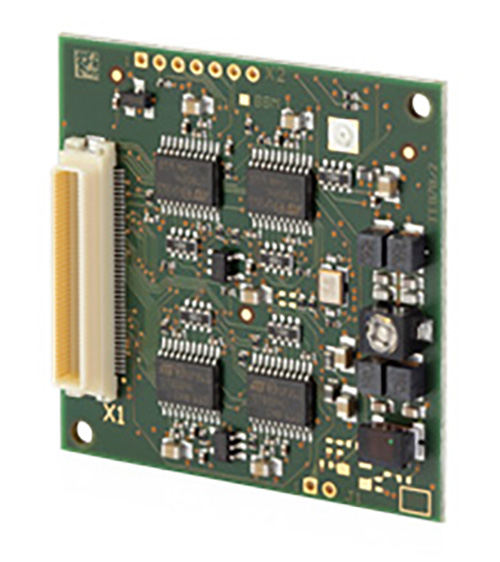Presented here are recent news announcements regarding the following organizations: Feig Electronics, Sectigo, ReFirm Labs, Telit, WISeKey, ToP Tunniste, Fentec Partners, and SimplyRFID.
Feig Electronics Intros New RFID Reader Terminal
Feig Electronics, a supplier of RFID readers and antennas, has announced the commercial availability of its CPR60 RFID reader module, designed for use in terminals, printers, handheld units and portable devices. The module features four interfaces for smart card contact units, the company reports, making it suitable for electronic ticket applications in the public-transport sector.
Allied Market Research has forecasted that the RFID reader market will grow to $22.5 billion by 2026, registering a compound annual growth rate of 9.8 percent. According to the research firm, portable and handheld RFID readers, for which the CPR60 module is designed, accounted for more than 60 percent of the total market in 2018, and this is expected to continue. The CPR60 also operates in the HF frequency band (13.56 MHz), and this segment of the reader market is anticipated to grow at a CAGR of 14.7 percent.

The simplicity and low cost of RFID technology has facilitated its adoption for a variety of uses, Feig Electronics reports, such as inventory management, toll collection, animal identification and tracking mobile medical equipment. Typical applications include security and access control, electronic payments, ticketing, e-passports, document tracking, patron management, product authentication, asset tracking, and medical uses such as patient management and pharmaceuticals tracking. The COVID-19 pandemic has highlighted the necessity for contactless payments via smart cards, with the need for RFID-based contactless solutions growing rapidly.
The CPR60 supports the HF ISO standards and offers multiple interfaces on a single reader, reducing hardware and integration costs and complexity. The CPR60 can connect to external antennas, and CPR modules come with support for developers: CPRStart software for test, configuration, and demonstration of the reading functions and a firmware update tool, as well as numerous software development kits and drivers to support integration into customer applications. A development board is available for testing functions and program interfaces and applications.
The module includes an embedded antenna, three SAM sockets (ID-000), a smart card connector (ID-1) and common connectors for USB, SPI and RS232 interfaces. According to the company, all Feig modules use the same API for integration, even with different protocols such as low-frequency (LF), high-frequency (HF) and ultrahigh-frequency (UHF), allowing integration in environments requiring various technologies.
Sectigo, ReFirm Labs Help OEMs Detect IoT Firmware Vulnerabilities
Sectigo, a provider of automated digital identity management and Web security solutions, has partnered with ReFirm Labs to help device original equipment manufacturers (OEMs) ensure security and compliance. Under the terms of the agreement, Sectigo’s customers will have access to ReFirm Labs’ firmware-scanning tools for analyzing device firmware and detecting known vulnerabilities, out-of-date open-source components, hard-code encryption keys, expired certificates and potential zero-day vulnerabilities.
Device firmware presents an unprotected attack surface that hackers can use to gain access to, and move laterally within, corporate or critical infrastructure networks, the companies explain. The growth of connected devices has escalated this risk, they add, leading several industry groups, including the U.S. Cyberspace Solarium Commission, to recommend stronger regulatory enforcement and clearer baseline standards and guidance for Internet of Things (IoT) device manufacturers and their supply chains to combat attacks on device firmware.

ReFirm Labs’ Centrifuge Platform provides an automated platform to analyze IoT and embedded device firmware in order to identify potential cybersecurity vulnerabilities before OEMs release firmware updates, and prior to deployment onto device operators’ networks. Sectigo’s IoT Identity Platform offers embedded device identity and integrity technologies, as well as certificate issuance and management.
OEMs using both Sectigo’s and ReFirm Labs’ platforms can create secure embedded software; guarantee the integrity of device software and validity of certificates at boot, as well as in software updates; protect devices by operating through secure boot, secure storage and embedded firewall technologies; detect hard-code encryption keys, expired certificates and other security vulnerabilities; and ensure compliance with such IoT security standards as NIST 8259, OWASP IoT Top 10 and ISA/IEC 62443.
“Sectigo’s IoT security platform was created to deliver end-to-end security for every connected device, at the point of manufacture and throughout the entire lifecycle,” said Alan Grau, the company’s VP of IoT and embedded solutions, in a prepared statement. “By teaming with ReFirm Labs, we are enabling device OEMs to address security and compliance requirements using a comprehensive solution that works across every stage of the device lifecycle.”
“Our partnership with Sectigo is an important advancement in addressing the growing market and regulatory pressure that is forcing device OEMs to adopt best practices for developing secure IoT device firmware,” added Derick Naef, ReFirm Labs’ CEO, in the prepared statement. “Using ReFirm Labs’ Centrifuge Platform, our OEM customers are able to uncover the vulnerabilities in IoT devices. They can then address those problems using Sectigo’s IoT Security platform, and ultimately implement higher levels of security and achieve compliance with new standards for device security.”
Telit Unveils IoT-as-a-Service Subscription Plans
Internet of Things (IoT) company Telit has announced packaged plans for connectivity and Telit OneEdge, its solution designed to reduce the time and complexity associated with adding IoT functionality to devices and services for consumer and enterprise applications. The IoT-as-a-service packaged plans provide businesses with the cellular module, software, services and network connectivity required to launch IoT applications. Teit’s offerings include its Primo and Lungo plans.
Lungo comes with Telit’s ME910C1 LTE Category M1/NB1 module, connectivity and a range of security, device-management, connectivity-management and data-orchestration features. Telit OneEdge-enabled modules offer Lightweight M2M (LwM2M), a protocol designed to reduce power and data consumption in response to the growing demands of the IoT, particularly for 5G. The plans enable businesses to create and manage IoT project budgets utilizing fixed pricing, the company reports, and are suitable for greenfield and proof-of-concept projects. Primo lets customers contract the same set of services, licenses and subscriptions as Lungo for existing or separately purchased OneEdge-capable Telit modules.
Introduced in 2019, OneEdge is built to address challenges related to IoT integration, scalability, management and costs. OneEdge features more than a dozen module variants and provides integrators with the flexibility to choose from regional to worldwide variants in different sizes and form factors. Zero-touch onboarding lets products operate automatically. Device-management standards-based LwM2M allows more efficient control of the module and data objects than MQTT and other legacy protocols, the firm notes, enabling and maintaining the device connection to the cloud or enterprise.
“As IoT adoption continues reaching beyond traditional verticals, we see an increased demand for the full breadth of IoT functionality, not only being delivered in packages to simplify integration and operation, but also being delivered more and more ‘as a service,'” said Dan Shey, ABI Research’s managing director and VP, in a prepared statement.
“With the launch of these IoT-as-a-service plans, we’re providing integrators and solution providers with business-friendly, cost-effective turnkey plans to transform their entire IoT investment—including the module—into a single, predictable operating expense,” added Manish Watwani, Telit’s chief marketing and product officer, in the prepared statement.
WISeKey IoT Early-Warning System Helps to Prevent COVID-19 Spread
Cybersecurity and IoT company WISeKey International Holding has announced that it has finalized the integration of an IoT early-warning system (EWS) designed to save lives through the detection of COVID-19. The company says its Foresight Platform is compatible with PEPP-PT Pan-European Privacy-Preserving Proximity Tracing, conceived as the backbone for national apps complying with Europe’s strict privacy rules and able to talk to each other across borders. The Foresight EWS is a component of the company’s Digital Transformation Plan.
WISeKey has provided several offerings to aid in the fight against COVID-19, including WIShelter and WISeTravel. Its technologies range from digital identities, artificial intelligence, blockchain and IoT semiconductors to cloud-based services and cybersecurity solutions. The company provides cybersecurity and IoT solutions to several large businesses and consumer brands, with customers currently utilizing 1.5 billion WISeKey-based chips in products that connect people, secure objects and enhance the interactions of machines with humans.
The Foresight platform includes WISeKey’s IoT network of interconnected systems, digital certification, data analytics, AI and connectivity. The company’s IoT sensors are equipped with its WIShelter app, capable of measuring temperatures and providing geolocation of targeted quarantines, providing an early-warning system to curb the spread of infectious diseases. “WISeKey uses its network of Blockchain Centers of Excellence in cooperation with enterprises, cities and national governments to collectively create a massive global network of IoT sensors interconnected to the Foresight Early Warning System,” the company explained in a prepared statement.
“Using the network of billions of interconnected smart IoT sensors, we can detect the spread of viruses by combining the anonymized digital identity with the behavior of a person,” the firm added in the statement. “However, this would require standardization, planning and implementation on a global scale and, a special focus on privacy, to develop the early warning system.” According to WISeKey, a lack of security increases the risk of personal information being hacked while the data is collected and transmitted to IoT devices connected with a consumer network. Unauthorized users might exploit existing security vulnerabilities if the infrastructure is not properly secured.
The first phase of the ultra-low-power Bluetooth 5 secure beacon implementation was developed using WISeKey’s VaultIC407, ON Semiconductor‘s RSL10 and N34TS108 temperature sensors, and Tatwah‘s BLE IT-005 IP68-class beacon. The device features a long battery life, the company notes, and the implementation allows replay attack protection, device clone protection, VaultIC absence detection, revocation capability, measurement validity check and true temperature display.
ToP Tunniste, Fentec Partners Unite to Develop RFID Solutions
Finnish RFID technology companies ToP Tunniste and Fentec Partners have announced a partnership, with the shares of both firms being transferred to the recently founded Fentec Group. Through this merger, Fentec Group will develop and implement turnkey RFID solutions, with the goal of seeking growth in both the Finnish and international markets. Jari Kinnunen has been appointed as Fentec Group’s CEO and will transfer to this position from Stora Enso’s Intelligent Packaging business unit.
Fentec Partners develops RFID-based smart spaces that can be placed, for example, within cabinets or containers. Its RFID products and services include 24-7 unmanned storage and warehouse solutions, and the firm owns several product patents. ToP Tunniste develops intelligent RFID identification and data-capture solutions designed to enhance processes and productivity in many sectors, including healthcare, logistics, manufacturing and services.
“Fentec Group boasts well known customer references and highly experienced and competent personnel,” the company said in a prepared statement. “Fentec Group relies on an international partner network and is interested in expanding that going forward. Customers will benefit from the merger through comprehensive, productized RFID solutions offering. Fentec Group offers its customers world-class RFID-based smart spaces and industry specific solutions for automatic identification.”
Pikespo Invest Oy, a Tampere-based private equity company, will be among Fentec Group’s owners. “It is great to be boosting a technology company with such a long market experience and deep technical expertise,” said Antti Rauhala, Fentec Group’s Chairman of the Board, in the prepared statement. “This is why customers’ trust us in the core of their operations. Neither of the companies were looking for a buyer. As companies’ strengths complemented each other so well, we found a common ground to start building an international growth story.”
“After operating in the RFID industry for so long, it is great to notice how an ever-increasing number of companies and end users benefit from RFID-based solutions,” added fellow Board member Samuli Strömberg in the prepared statement. “According to our strong customer references, 24-7-available unmanned storage and warehouse solutions and smart spaces create undeniable customer benefits. These solutions have growing demand in the global marketplace.”
SimplyRFID Releases How-to Guide for RFID-based Inventory Counts
With its recent release of its “RFID Cookbook,” SimplyRFID says it intends to showcase the potential that RFID technology provides to end users that have developed customized solutions to simplify inventory management and increase efficiency. The software and hardware development company, which produces RFID tracking systems, has tracked millions of IT servers, trash cans, drugs, military equipment and laptops for customers around the world.
According to SimplyRFID, its RFID chips can be attached to almost any asset, enabling users to monitor items’ movements. With its RFID Cookbook, the firm says it hopes to help companies improve their operations by providing an introduction for new users of the technology, explaining how RFID solutions are modernizing and simplifying time-consuming processes across a range of industries. Although the RFID Cookbook does not provide a deep dive into the intricacies and technology behind RFID, the company notes, its how-to guides are intended to offer inspiration and ideas for how the technology can be applied to users’ businesses or projects, as well as how they can get started with their own projects.
“Organizations new to RFID are often surprised at how much time and money they save through increased efficiency and workflow improvements,” the company indicated in a prepared statement. “In no time, users can develop their own inventory-management solutions that work best for them. The RFID Cookbook also includes detailed metrics on how much time companies can save, on average, when they modernize and streamline dated legacy processes with RFID technology.”


